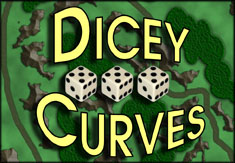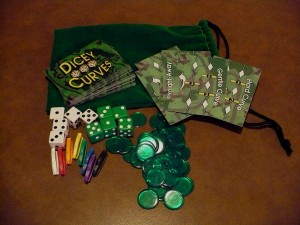Of Dice and Cars - A review of Dicey Curves
/ -by JeremiahMatt Worden of Matt Worden Games was kind enough to send me a review copy of his racin' and rollin' dice game Dicey Curves. I finally had the chance to pull it out and give it a test drive. Want to know what I thought? Good, keep reading...
The Basics - The player’s turn breaks down pretty simply for this party game of up to 8 players: Roll Dice, Move Cars, and Gain Control Chips (if possible). Each player rolls at least 5 d6 (Six sided dice) on their turn, and for every 6 you roll, you get to add an extra d6 and re-roll both the 6 and the extra die. You then group them up in pairs, triples, doubles, etc. (pairs consist of either of matching numbers or sequential numbers). Having a triple allows you to move a race car along the track 3 "spots", a quad 4 spots, etc. You can play a single, but it will mark the end of the movement of that car for that turn (players can -and should- control multiple cars in a game, if there are less than 8 players).
-by JeremiahMatt Worden of Matt Worden Games was kind enough to send me a review copy of his racin' and rollin' dice game Dicey Curves. I finally had the chance to pull it out and give it a test drive. Want to know what I thought? Good, keep reading...
The Basics - The player’s turn breaks down pretty simply for this party game of up to 8 players: Roll Dice, Move Cars, and Gain Control Chips (if possible). Each player rolls at least 5 d6 (Six sided dice) on their turn, and for every 6 you roll, you get to add an extra d6 and re-roll both the 6 and the extra die. You then group them up in pairs, triples, doubles, etc. (pairs consist of either of matching numbers or sequential numbers). Having a triple allows you to move a race car along the track 3 "spots", a quad 4 spots, etc. You can play a single, but it will mark the end of the movement of that car for that turn (players can -and should- control multiple cars in a game, if there are less than 8 players).
Control chips - allow you to do some nifty maneuvers depending on the phase of your turn. If you're rolling dice you can add a d6 set to any number 1-5, or re-roll any amount of dice already in play. If you're moving cars already they give you the ability to continue playing dice after you've played a single; juke, which switches spots with a car next to yours; or take control of another player’s car. I mostly found that using them to continue playing dice after a single allowed for optimal use of your dice in a turn and didn't use them for much else while moving cars. You gain control chips by turning in unused dice at the end of your turn.
The Race Track - is made of cards revealed at random from a shuffled deck. There is no set length to the race, you simply tuck the finish line somewhere in the deck and fire up your engines. The track consists of three elements, Spots, Paths, and Gates. Spots determine how far you can go depending on the dice groups you roll, Paths determine how you move between spots, and Gates are essentially roadblocks that require a specific group to be played before allowing the racer to pass. The Gates simulate the degree of difficulty for certain turns or areas of the track, requiring racers to throttle down to navigate. There is also a suggested variant for setting up the track first in a circle around the table, but I found the uncertainty of not knowing what was coming around the next bend more exciting!
 My Final Thoughts -I definitely recommend playing the game with as many cars on the table as possible. We found that with only 4 cars in the race it was very easy for a player to pull out to a lead and never look back. It's also important that the deck gets shuffled well!! I can't stress that enough, as a section of our first walk through yielded a Straight Away or Wide Open card 7 out of 8 pulls which added no challenge to the game. I wasn't a huge fan of the artwork either, but the components were overall what you'd expect from an indie publisher and the game itself holds up well.
My Final Thoughts -I definitely recommend playing the game with as many cars on the table as possible. We found that with only 4 cars in the race it was very easy for a player to pull out to a lead and never look back. It's also important that the deck gets shuffled well!! I can't stress that enough, as a section of our first walk through yielded a Straight Away or Wide Open card 7 out of 8 pulls which added no challenge to the game. I wasn't a huge fan of the artwork either, but the components were overall what you'd expect from an indie publisher and the game itself holds up well.
What I took away from Dicey Curves was a quick moving, fun party game, the control chips were well thought out, and remove a good chunk of randomness from the game and inject a healthy shot of strategy into a game that would otherwise be completely left to the luck of a roll. The Dicey Curves expansion Danger! Was just released, I'll be reviewing that soon, so stay tuned! You can grab a copy of Dicey Curves right here!













